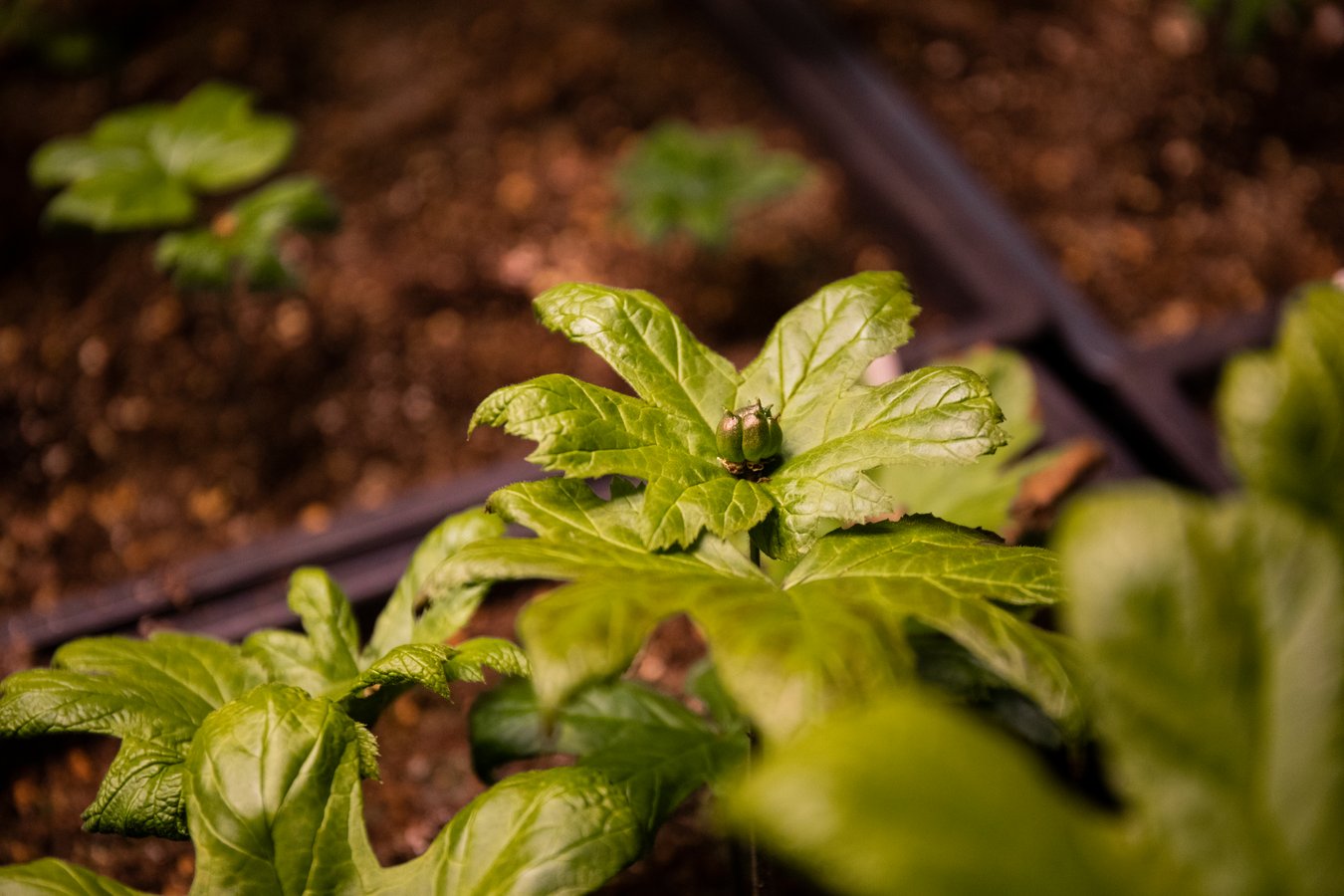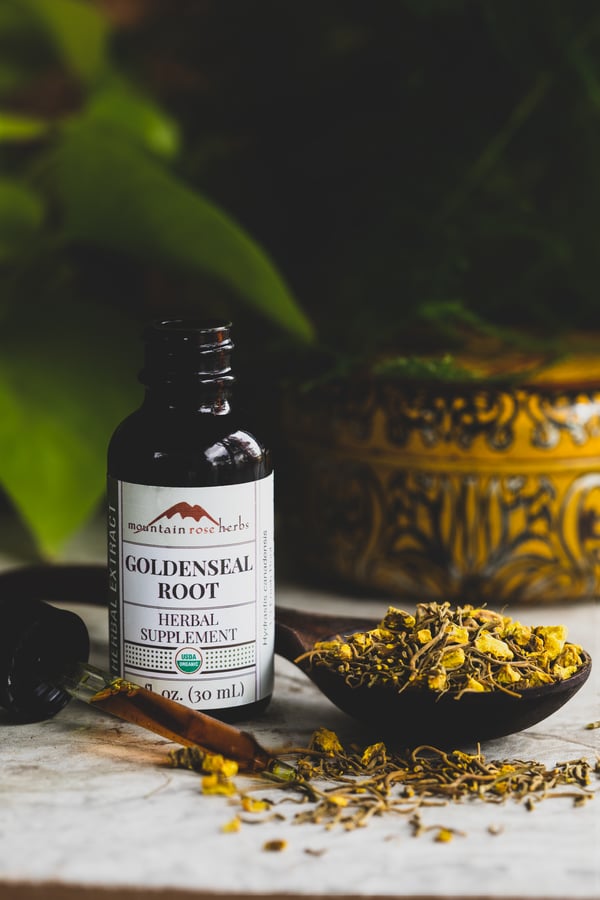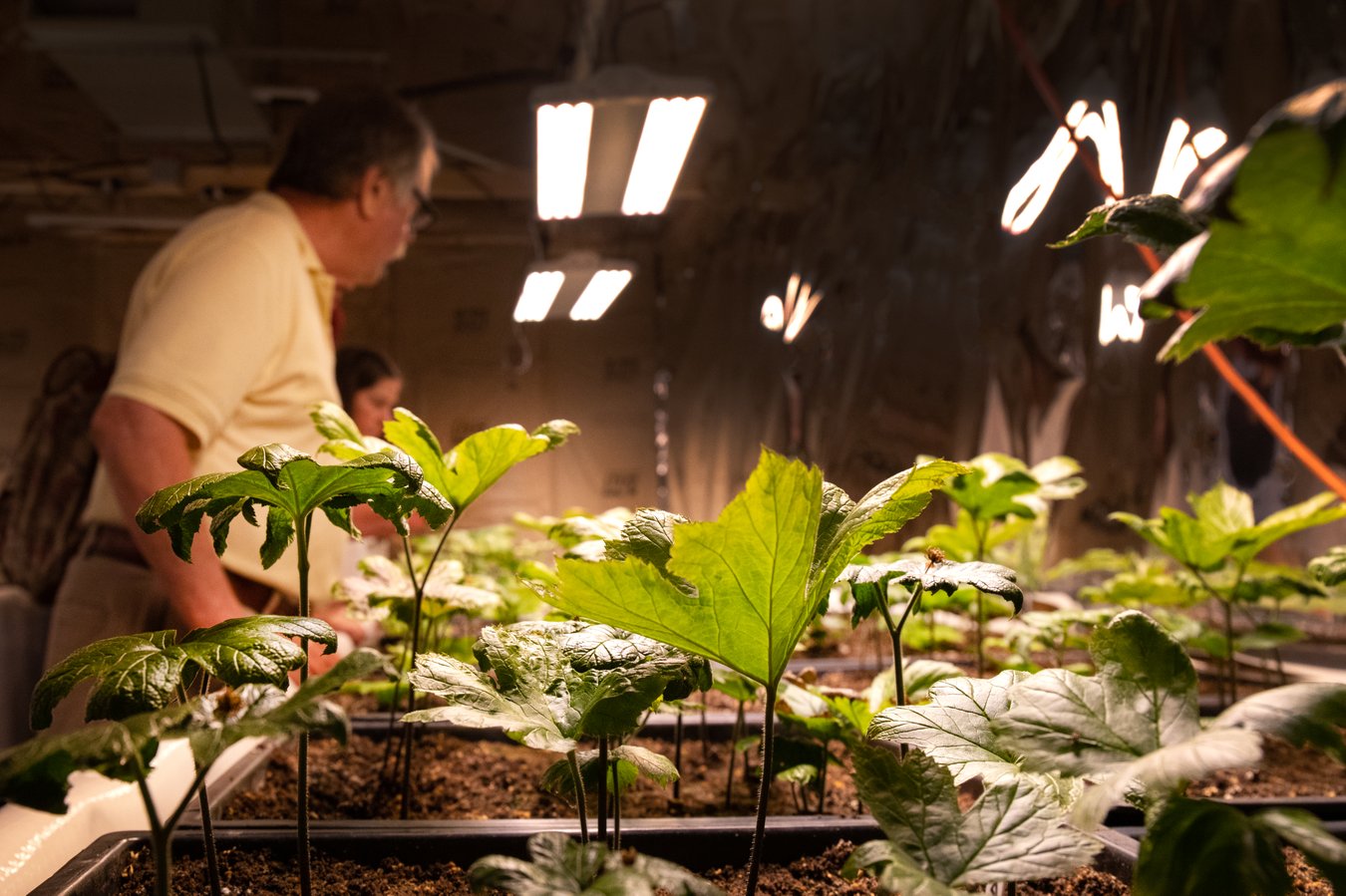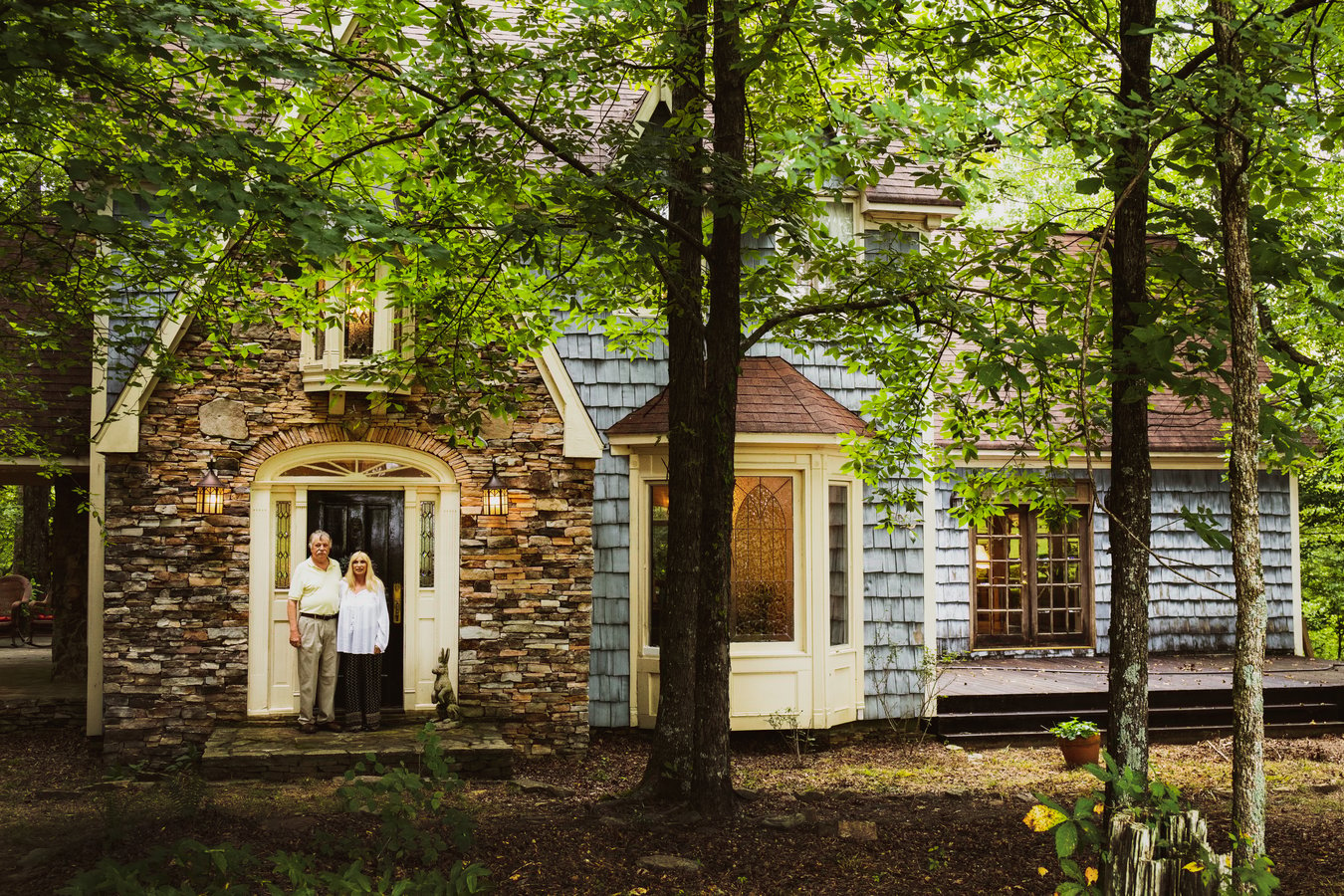Although goldenseal (Hydrastis canadensis) was used by First Nations peoples for hundreds of years before Europeans arrived in the Americas, the first written source regarding goldenseal appears in an 1801 series of essays by botanist and physician Benjamin Smith Barton titled Towards a Materia Medica in the United States. Early colonists found a well-established trade network already in place for medicinal herbs, including goldenseal. Indigenous people used it as a dye and also for a variety of health issues, including as a bitter to support digestion, as a skin and eye wash, and as a dental rinse. By the 1830s, goldenseal was also a favorite of practitioners of Eclectic medicine, and demand was increasing exponentially. That demand has never let up and today goldenseal is considered to be one of the most at-risk herbs on United Plant Savers' At-Risk Medicinal Plants List. There is, however, a potentially bright future for goldenseal thanks to innovations in cultivation.
Goldenseal Botany
Goldenseal (Hydrastis canadensis) is a member of the 2,252-species-strong buttercup family (Ranunculaceae) but is thought to be a “monotypic genus,” which means that botanists consider it to be the only living representative of its genus (Hydrastis). It is found exclusively in North America’s Eastern hardwood forests where it thrives in the loamy soil and semi-shade with its roots protected and kept moist by deep layers of decaying hummus and leaf litter. Its ideal growing environment is a spot that is 60-80% shady—more sun causes stunting and yellowed leaves and less sun slows growth and limits fruit and seed production. And it also prefers areas that are wet in the spring and moist the rest of the year, so stream banks, spring seeps, drainages, flood plains, and the like are its happy place.
Goldenseal is a slow developer with a three-stage life cycle: a seedling stage, a juvenile stage, and a reproductive stage. It can take up to three years for seeds to germinate, and then the plant remains in the seedling stage for up to two more years. During this time, it has just tiny round cotyledons (seed leaves). In the second or third year of its life, it develops its first true leaf and a root system begins to branch out underground. Finally, sometime between its fourth and sixth year, it reaches maturity, grows a fragile forked stem about six to eight inches tall with a pair of leaves, and is ready to bloom.
When the mature plant emerges from the ground in the spring and begins to open its leaves, a single, small, white flower promptly blooms at the leaf level. This flower is generally pollinated by small bees and syrphid flies, but if none come along, it can also fertilize itself. Although it can reproduce in this manner via seed production, it more often increases its population through clonal propagation. Below ground, rhizomes sprout thin, fibrous rootlets that twine together with companion plants like black and blue cohosh, false unicorn, bloodroot, etc. These intertwined root systems can form clusters and spread out in large patches. Goldenseal’s rootlets form what are called “adventitious buds” that swell and eventually sprout into a new goldenseal seedling that is genetically identical to the parent plant. The cycle then repeats itself, each new bud giving the growing colony more opportunity for clonal propagation to increase the plant population. This growth strategy is ideal in undisturbed woodlands.
Goldenseal Benefits
Goldenseal contains wellness-supporting alkaloids like berberine, hydrastine, and canadine and is largely known for its support of the immune system. While its beneficial constituents exist throughout the whole plant, including the leaves and stems, the greatest concentration and commercial value are in the roots.
Historically, goldenseal roots have been used as a wash for a variety of skin, eye, and mouth issues. First Nations peoples took goldenseal for upper respiratory complaints, wound care, and digestion support.* Reportedly, grinding the roots and mixing them with bear fat also made a very effective, if somewhat smelly, insect repellent. And boiling the roots produced a widely used fabric dye.
Among European colonists, goldenseal became a mainstay in the early American pharmacopeia, used for infections, digestive disorders, mouth issues, and wound care.* It continued to be a primary ingredient in the arsenal of 19th and early 20th century physicians until the development of antibiotics in the 1940s.
Caution: Goldenseal should not be used with children, particularly infants, and should be avoided during pregnancy and while nursing a child except under the supervision of a qualified healthcare practitioner. Also, if you are taking medications, please consult with your doctor before taking goldenseal.
Goldenseal’s History of Wildharvesting
Before colonization, goldenseal was abundant across the deciduous forests of eastern North America. By the mid-1800s, however, it had become the most popular herbal remedy of the day, with a thriving commercial trade. The increasing demand for this botanical created multiple problems. As the commercialization of goldenseal-based products increased demand, the sheer volume of harvesting became relentless. And the clonal propagation growth strategy that goldenseal had so successfully employed for millennia in the undisturbed ancient woodlands made it particularly vulnerable to the physical presence of so many collectors who trampled and compacted the decaying leaf-litter and humus that protected goldenseal’s delicate rhizomes and rootlets. This new large-scale wildharvesting created disturbances of the soil and rhizome systems that goldenseal colonies couldn’t overcome.
At the same time, the huge swaths of undisturbed ancient forests that goldenseal depends upon were steadily being cut down for timber and to create space for roads, agriculture, urban expansion, and recreational use. From the earliest days, people expressed concern that the ongoing level and manner of wildharvesting was not sustainable, particularly when combined with such catastrophic habitat loss. Between 1884-1887 John and Curtis Lloyd published a series of quarterly bulletins called Drugs and Medicines of North America, in which they reported that habitat destruction had already had a severe effect on goldenseal populations in the wild.
In the early 1900s people began exploring the possibility of cultivating goldenseal as a crop. The United States Department of Agriculture produced several bulletins on the topic. But forest farming turned out to be cost-prohibitive for most people and the profitability of growing goldenseal through traditional forest-farming practices fluctuated wildly. Multiple attempts at establishing a cultivated source for commercial sale failed and wildharvesting continued on a massive scale. In 1908 it was estimated that more than 300,000 pounds of goldenseal roots were harvested annually, which equals millions of plants every year. Wildharvesting continues to be the primary source for commercial sale of goldenseal today.
This once widespread species has been reduced to scattered remnant populations. According to the Convention on International Trade in Endangered Species of Wild Fauna and Flora (CITES) goldenseal is native in twenty-seven U.S. states and is considered critically imperiled, imperiled, or uncommon in seventeen of them, and is designated as endangered in six. Four others report some level of rarity; for instance, it is fairly rare in Oklahoma. There is no longer any U.S. state in which goldenseal is considered common. The American Botanical Council reports that it is “increasingly difficult to find even a single population of goldenseal in many forests where they were formerly abundant.” The situation is the same in Ontario, Canada, the only province in which it is native—in 1995 alone, wildharvesters destroyed approximately thirteen government-verified goldenseal colonies. The Nature Conservancy has classified goldenseal as “very threatened rangewide.”
And yet, the Food and Agriculture Organization (FAO) of the United Nations tells us that goldenseal continues to be one of the best-selling herbs internationally. It is a component in at least 300 homeopathic remedies produced in Europe, Scandinavia, and Australia. In 1994-1995 alone, over six million goldenseal roots were shipped overseas.
Goldenseal was listed in Appendix II of CITES on September 18, 1997, in both the United States and Canada. This listing means that anyone planning to export goldenseal from either country or to re-export it from anywhere else in the world must now apply for an export permit, which will be granted or not based on whether the material is legally acquired and whether or not wildharvesting will be detrimental to the survival of the species.
Meanwhile, a variety of groups are working together in hopes of restoring goldenseal in the wild and creating a sustainable future for this botanical, including the U.S. Forest Service and state government agencies. The CITES listing was a good first step but full protection is going to require partnership and cooperation at all levels.
Cultivating Goldenseal for a Sustainable Future
It is possible to successfully cultivate goldenseal in its natural habitat and we highly recommend planting this precious botanical if you own appropriate land. However, repeated attempts to establish a viable forest-farmed supply that can meet market demand and reduce the pressure on wild populations has consistently proven to be both cost-prohibitive and inconsistent in terms of profit for farmers.
We are particularly excited, therefore, to support Appalachian Sustainable Development (ASD) and their work with Sleepy Hollow Herb Farm. ASD was established in 1995 with a mission to build regional food and agricultural systems that support healthy communities and create sustainable opportunities for local farmers. Through ASD, we met Cindi and Randy who are pioneers in goldenseal cultivation and are third-generation owners of Sleepy Hollow Herb Farm, a certified organic working farm that is tucked in the foothills of the Appalachian Mountains along Spring Creek.
Originally, the couple established a co-op with other farmers with the intent of supporting regional forest farming. But they were up against the same barriers as previous generations—forest farming of goldenseal requires appropriate land, it has high up-front costs, and profitability is hit and miss. Randy explains, “It became obvious that forest production was not necessarily going to be the primary mode of growing goldenseal.”
In 2001, Randy began working with Clemson University to develop a way to grow goldenseal in a more controlled environment, where it would be safe from deer that eat the leaves and voles that eat the roots. Over the next decade, they researched ways to cultivate goldenseal without losing the attributes—including chemical marker content and bioactivity—that make it such a beloved and useful herb. And they succeeded!
“We were able to develop a system that we believe is going to be the answer to wild collection,” says Randy. “As the system is more widely adapted and more farmers come online, then the production will be great enough to handle the market need and even expand it.”
One of the glories of this new method of cultivating goldenseal is that small, family-operated farms anywhere in the world can do it; now you don’t need Eastern Woodland property to successfully grow goldenseal. And the system is incredibly scaleable, so growers can start small with less initial investment and then scale up as quickly as is reasonable for their unique situation. Also, this system allows for better use of the entire plant, rather than just the roots, so there is less waste of the precious botanical.
Randy and Cindi’s leadership in producing sustainable, cultivated goldenseal has earned them nine awards from the USDA and the National Institutes of Health, including awards for seed germination, production and processing, and manufacture of goldenseal products for use in clinical studies. Their expertise and drive also led to a new USDA National Organic Program that certifies production, processing, and a standardization system for this precious botanical. The program is working hand-in-hand with Sleepy Hollow Herb Farm to teach other farmers how to grow goldenseal. Already twenty-five small farmers in the U.S. Southeast have come to the farm to learn how to successfully cultivate goldenseal and expand their own plantings. These farmers have also joined together to establish Botanipharm, LLC, the first 100% grower-owned botanical processing cooperative in the United States.
By investing in research and education, and partnering with organizations like ASD and dedicated farmers like Randy and Cindi, Mountain Rose Herbs is doing what we can to find new ways to alleviate the pressures that at-risk herbs like goldenseal face in the wild. Cultivation is the key to supporting their sustainable future!
Want to Know How You Can Support Another Endangered Herb?
Read about Black Cohosh: A Powerhouse Herb to Use and Source Mindfully
You may also enjoy:
- Bloodroot: How We Can Create a Bountiful Future for an At-Risk Herb
- Trillium Plant: An Age-Old Ally That Needs Our Help
- Benefits and History of Slippery Elm Bark + Tea Recipe
*These statements have not been evaluated by the Food and Drug Administration. These products are not intended to diagnose, treat, cure, or prevent any disease. We recommend that you consult with a qualified healthcare practitioner before using herbal products, particularly if you are pregnant, nursing, or on any medications. For educational purposes only.

















